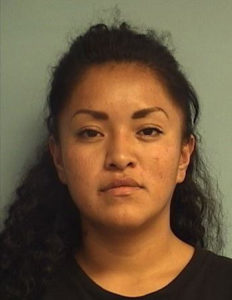- Trudy Martinez pleaded guilty to voluntary manslaughter and a firearm enhancement
- Martinez shot her sister-in-law, Cornelia McCabe, in the abdomen in Twin Lakes, in front of at least one of the woman’s children
- She faces a minimum sentence of 10 years and a max of 15 years
- Sentencing is tentatively set for Aug. 24, 2020
ALBUQUERQUE, N.M. — A Twin Lakes woman pleaded guilty, March 16, 2020, to voluntary manslaughter and a firearm enhancement for shooting and killing her sister-in-law with an AR-15 in April 2019.

Trudy Martinez, 29, of Twin Lakes, will spend at least 10 years in prison for killing Cornelia McCabe, 36, her sister-in-law. She is identified in court documents as C.M.
Martinez pleaded guilty in front of federal Magistrate Judge Paul Briones who deferred acceptance of the plea to the district judge sentencing her in the case, according to the minutes.
When she was first arrested, Federal Bureau of Investigations agents charged her with an open count of murder.
Federal prosecutor Thomas Aliberti signed the plea deal and filed the criminal information charging her with voluntary manslaughter and the firearm enhancement. Voluntary manslaughter carries a maximum sentence of 15 years while the firearm enhancement carries a minimum 10-year sentence.
According to the plea deal, Martinez intentionally killed McCabe during a sudden quarrel and therefore, without malice.
One of McCabe’s children told investigators she witnessed her mother’s killing and that Martinez first pushed her mother before going back to her truck to retrieve an AR-15 carbine, which she then loaded in the house, FBI Agent Jeffrey Wright wrote in an affidavit for an arrest warrant. McCabe is referred to as “Jane Doe” in his affidavit.
“DOE attempted to take the rifle away from Martinez,” Wright wrote. “As DOE approached MARTINEZ at the entrance to the Hogan, MARTINEZ pointed the rifle at DOE and fired the weapon two times. The first round missed DOE, but the second round struck DOE in the abdomen, after which DOE fell to the floor.”
Sentencing is tentatively scheduled for Aug. 24, 2020, at 10 a.m. in the Cimarron Courtroom in Albuquerque in front of District Court Judge William Johnson. It was moved to August after Martinez’s attorney, Irma Rivas, filed an unopposed motion to push out the sentencing date because Martinez wants her pretrial interview to be in person but the coronavirus pandemic has eliminated in-person visits at the Santa Fe County Detention Center, where she is being housed.
Continue reading “Woman pleads guilty in 2019 Twin Lakes killing”
